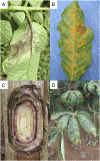The persistent threat of emerging plant disease pandemics to global food security
- PMID: 34021073
- PMCID: PMC8201941
- DOI: 10.1073/pnas.2022239118
The persistent threat of emerging plant disease pandemics to global food security
Erratum in
-
Correction for Ristaino et al., The persistent threat of emerging plant disease pandemics to global food security.Proc Natl Acad Sci U S A. 2021 Oct 5;118(40):e2115792118. doi: 10.1073/pnas.2115792118. Proc Natl Acad Sci U S A. 2021. PMID: 34588314 Free PMC article. No abstract available.
Abstract
Plant disease outbreaks are increasing and threaten food security for the vulnerable in many areas of the world. Now a global human pandemic is threatening the health of millions on our planet. A stable, nutritious food supply will be needed to lift people out of poverty and improve health outcomes. Plant diseases, both endemic and recently emerging, are spreading and exacerbated by climate change, transmission with global food trade networks, pathogen spillover, and evolution of new pathogen lineages. In order to tackle these grand challenges, a new set of tools that include disease surveillance and improved detection technologies including pathogen sensors and predictive modeling and data analytics are needed to prevent future outbreaks. Herein, we describe an integrated research agenda that could help mitigate future plant disease pandemics.
Keywords: emerging plant disease; food security; plant pathology.
Conflict of interest statement
The authors declare no competing interest.
Figures



References
-
- Food and Agriculture Organization of the United Nations , The State of Food and Agriculture 2019: Moving Forward on Food Loss and Waste Reduction (Food and Agricultural Organization, Rome, Italy, 2019).
-
- Fedoroff N. V., Food in a future of 10 billion. Agric. Food Secur. 4, 11 (2015).
-
- Savary S., et al. ., The global burden of pathogens and pests on major food crops. Nat. Ecol. Evol. 3, 430–439 (2019). - PubMed
-
- Delgado L., Schuster M., Torero M., “The reality of food losses: A new measurement methodology” (IFPRI Discussion Paper 1686, International Food Policy Research Institute, Washington, DC, 2017). http://ebrary.ifpri.org/cdm/ref/collection/p15738coll2/id/131530.
-
- National Academies of Sciences, Engineering, and Medicine , Science Breakthroughs to Advance Food and Agricultural Research by 2030 (National Academies Press, Washington, DC, 2019).
Publication types
MeSH terms
LinkOut - more resources
Full Text Sources
Other Literature Sources
Medical

